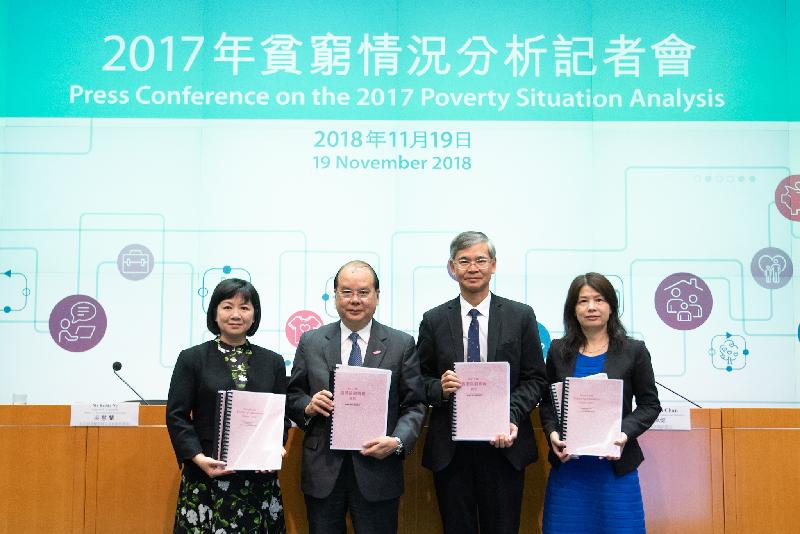Analysis of poverty situation in Hong Kong in 2017 announced (with photo/video)
*******************************************************************************
This is the sixth annual update of the poverty situation analysis by the CoP since the publication of the first official poverty line by CoP in 2013.
Mr Cheung said, "In 2017, the poverty rate before policy intervention was 20.1 per cent. After recurrent cash policy intervention, the poverty rate maintained at 14.7 per cent, the same level as that of 2016. This demonstrates Hong Kong's overall poverty situation remained largely stable and the increased effectiveness of the Government’s poverty alleviation work."
As for poor population, the poor population before and after policy intervention both recorded a slight increase (to 1 376 600 persons and 1 008 800 persons respectively), similar increases were seen in recent years, partly affected by structural changes in demographics and household size. With a broad-based tightening of the labour market and a notable expansion of the economy, overall wages recorded an year-on-year increase of 3.8 per cent. Alongside the increase in wages, there was a general increase of the poverty line thresholds by household size. For example, the poverty line threshold for 4-person households increased to $19,900, representing a 7.6 per cent increase from 2016.
Other than recurrent cash measures, the Government has been rendering a lot of resources to provide grassroots with various in-kind benefits, in particular public rental housing (PRH). Taking into account the in-kind benefits (mainly comprising PRH), an additional 288 000 persons were lifted out of poverty, and the post-intervention poverty rate was further reduced to 10.5 per cent. This indicates the important role of PRH in poverty alleviation work. The effectiveness of PRH in reducing grassroots' housing expenditure and thereby improving their livelihood is beyond doubt. Non-recurrent cash measures further reduced the post-intervention poverty rate to 13.9 per cent.
Mr Cheung pointed out that the poverty statistics reflected the outcome of various factors at play, including the implementation of the Government's poverty alleviation initiatives, the number of beneficiaries involved, the economic situation, the change in overall employment income, and demographic changes, some of which were beyond the Government’s control. In addition, the poverty alleviation effectiveness of some non-means tested relief measures, such as the Elderly Health Care Voucher, the Government Public Transport Fare Concession Scheme for the Elderly and Eligible Persons with Disabilities were not captured by the poverty line analytical framework. The slight increase in the overall poor population in 2017 did not imply a reduction of resources nor the effectiveness of the Government's poverty alleviation work. In fact, the Government's recurrent expenditure on social welfare has been on a rise. In 2018/19, that expenditure was estimated to reach $79.8 billion, representing a substantial growth of 86 per cent compared to that on 2012/13. This demonstrates the Government’s steadfast commitment in poverty alleviation.
On the effectiveness of policy intervention, Government recurrent cash measures continued to provide effective support to poor households in 2017, lifting 367 900 persons out of poverty, and the poverty rate was reduced by 5.4 percentage points, one percentage point more than five years earlier. Among various measures, the means-tested Comprehensive Social Security Assistance (CSSA) and the Old Age Living Allowance (OALA) were most impactful on poverty alleviation, respectively reducing the overall poverty rate by 2.5 percentage points and 2.0 percentage points.
It is worth mentioning that, with the implementation of the enhanced OALA since May 2017, the poverty situation statistics in 2017 only reflected its impact on poverty alleviation for eight months, its full year effect will be reflected in the poverty situation statistics in 2018. In 2017, OALA lifted 91 200 senior citizens out of poverty, reducing the elderly poverty rate by 8.2 percentage points. OALA was the most effective measure in alleviating elderly poverty amongst various recurrent cash policies. In addition, the improved Low-income Working Family Allowance (LIFA), renamed as the Working Family Allowance (WFA), has been implemented since April 2018. As the claim period of WFA covers the past six months, its effect (from one to three months) was partially reflected in the poverty statistics analysis in 2017. It drove down the child poverty rate by 1.1 percentage points, higher than that achieved in 2016. Its effectiveness was also comparable to that of the poverty alleviation effectiveness of education benefits. This reflects that the scheme was helpful to children in poor working households, and thereby alleviating inter-generational poverty.
Looking ahead, in view of the rapid structural population ageing, the continued upward adjustment of the poverty line thresholds alongside wages increase as well as the fact that the poverty line only takes into account income but not assets, there would be not much room for significant improvement in the poverty figures in future. However, various measures on poverty alleviation and support for the elderly, including OALA, WFA, and the Life Annuity Scheme launched by the HKMC Annuity Limited have been rolled out and their effectiveness will be reflected in future poverty situation analyses. The Government will continue to monitor the effectiveness of these measures.
The "Hong Kong Poverty Situation Report 2017" and the presentation slides on the analysis of the poverty situation in 2017 have been uploaded to the CoP’s dedicated website (www.povertyrelief.gov.hk).
Ends/Monday, November 19, 2018
Issued at HKT 17:31
Issued at HKT 17:31
NNNN
Photo
Audio / Video
Press conference on analysis of poverty situation in Hong Kong in 2017





